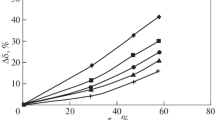Conclusions
The investigation carried out showed that the velocity of transverse expansion of a “reduced” flow of combustion products can be used as the characteristic velocity of diffusion combustion, and the width of this flow can be used as a linear dimension, characterizing the degree of burnup.
The physical basis for the velocity of diffusion combustion coincides completely with the well-known ideas in the literature concerning the velocity of laminar and turbulent homogeneous combustion, and therefore it is possible to compare the intensities of all three types of combustion. During the experimental investigations of turbulent homogeneous combustion, it was more useful to measure not the flame propagation velocity with respect to its leading edge, as is usually done, but the combustion velocity, which is unambiguously related to the rate of heat release.
The preliminary comparison, carried out between the velocities of diffusion and homogeneous combustion, indicates the significant reduction of the heat-release intensity in a diffusion flame jet in comparison with a homogeneous flame jet, which, obviously, is explained by the complexity of the mixing process which precedes the chemical reaction.
Similar content being viewed by others
Literature Cited
A. G. Prudnikov, in: Problems of Turbulent Combustion [in Russian], Oborongiz, Moscow (1960).
E. S. Shchetinkov, Physics of the Combustion of Gases [in Russian], Fizmatgiz, Moscow (1965).
Sh. A. Ershin, Doctoral Dissertation, Kazakh Scientific-Research Institute of Power, Alma-Ata (1972).
R. Günther and H. Simon, in: Twelfth International Symposium on Combustion (1969), pp. 1069–1079.
V. F. Sokolenko, Candidate's Dissertation, Institute of Chemical Kinetics and Combustion, Novosibirsk (1974).
B. Haushorn et al., in: Problems of Combustion [Russian translation], Vol. 1, IL, Moscow (1953).
V. K. Baev and V. A. Yasakov, Fiz. Goreniya Vzryva,11, No. 1, 138 (1975).
V. P. Karpov et al., Dokl. Akad. Nauk SSSR,32, 1341 (1960).
A. S. Ginevskii et al., Izv. Akad. Nauk SSSR, Mekh. Zhidk. Gaza, No. 4, 88 (1966).
V. I. Andreev, in: Theory and Practice of Gas Combustion [in Russian], Nedra, Leningrad (1964).
S. M. Il'yashenko and A. V. Talantov, Theory and Calculation of Straight-Through Combustion Chambers [in Russian], Mashinostroenie, Moscow (1964).
Yu. V. Ignatenko and V. F. Sokolenko, Fiz. Goreniya Vzryva,7, No. 4, 585 (1971).
Additional information
Institute of Problems of Mechanics, Academy of Sciences of the USSR, Moscow. Translated from Fizika Goreniya i Vzryva, Vol. 12, No. 4, pp. 483–493, July–August, 1976.
Rights and permissions
About this article
Cite this article
Shchetinkov, E.S. Velocity of combustion of a turbulent diffusion flame jet. Combust Explos Shock Waves 12, 435–444 (1976). https://doi.org/10.1007/BF00741132
Received:
Issue Date:
DOI: https://doi.org/10.1007/BF00741132



